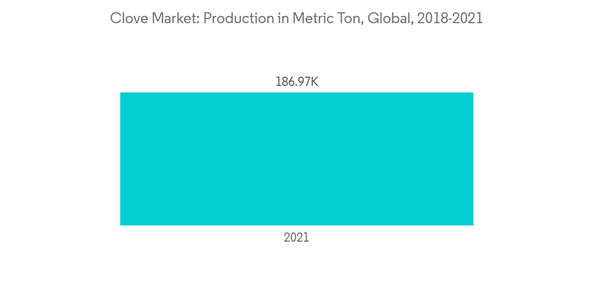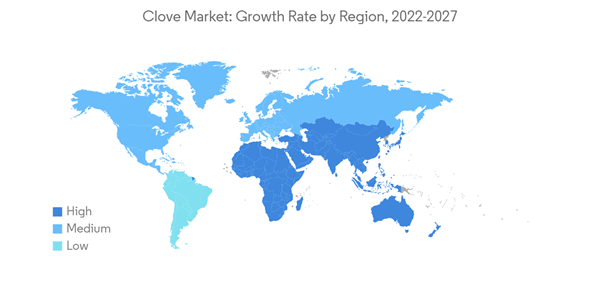The Clove Market size is estimated at USD 5.80 billion in 2024, and is expected to reach USD 6.95 billion by 2029, growing at a CAGR of 3.70% during the forecast period (2024-2029).
The changing consumer preference toward the use of herbal and natural products, due to greater effectiveness and absence of side effects, has led to an increased demand for cloves. . Additionally, Cloves are in high demand among natural, herbal, and organic product manufacturers because they are employed as herbal or natural ingredients in toothpaste, perfumes, skincare, hair care, scents, and other products. The increased applications coupled with the health benefits increase the demand thereby raising production. For instance, according to FAO, the production of cloves increased from 179,942 metric ton in 2018 to 186,969 metric ton in 2021.
Also, the emerging demand for herbal supplements among middle-aged women and older adults is a factor driving the market growth. The increased disposable income of consumers in developed countries, coupled with the enhanced consumption of natural products, is expected to drive the market for cloves during the forecast period.
Clove production in Indonesia has been increasing over the years. As per FAO, the clove production amounted to 134.7 thousand metric ton in 2019, with 569.4 thousand hectares of cultivated area. The production showed a slight decline to 133.6 thousand metric ton in 2020, which was cultivated in 552.8 thousand hectares of land. Bad weather is a factor that immensely affects clove production.
Moreover, domestic clove production is generally oriented towards meeting domestic needs, namely as raw material for the kretek cigarette industry. Additionally, Clove plants can produce three types of essential oils, including clove oil, clove stalk oil, and clove leaf oil. Clove oil is a commodity that has great potential in Indonesia. The increased domestic consumption at a rapid pace gives rise to imports from other countries.
Furthermore, about 90% of the production is used for local consumption and the remaining is exported to different countries. In 2021, India, Singapore, Bangladesh, the United Arab Emirates, United states, and Pakistan were some of the major export destinations for Indonesian cloves. India is the leading importer from Indonesia, accounting for 29.1% of Indonesia's exports in 2021. The export of clove to India amounted to 5,738 ton, which was valued at USD 28,051 thousand in 2021. With the rising global demand and significant clove production in Indonesia, the export is anticipated to increase steadily during the forecast period.
This product will be delivered within 2 business days.
Key Highlights
- Clove is one of the most valued species because of its increased usefulness in foods and personal care products. Many health benefits associated with cloves are the major driver for the market. It contains vitamins C, K, E, calcium, and magnesium and is rich in antioxidants. Their use helps to cure a lot of health-related problems such as cough and cold, toothache, etc. Along with this, clove oil can be used in personal care, cosmetics, and health care products.
- Furthermore, the production of cloves is largely found in Indonesia with a production volume of 133,604 metric ton in 2020 as per FAO, which accounted for global output of nearly 72.9%. Other large producers of cloves include Madagascar, Tanzania, Comoros, and Sri Lanka. Being the largest producer of cloves, Indonesia is also the largest consumer in the world. It consumes around 90% of its own clove production.
- Cloves are usually sold in unbranded packages or in bulk. However, this trend is shifting as consumers demand branded and packaged products that validate the authenticity of the spice with labels that communicate important information about the ingredients used. The growing demand across the world is aided by rising consumption due to its medicinal properties.
Clove Market Trends
Increased Demand from Various Industries is Aiding the Production
The rise in demand for herbal and natural products and medicines boosted the cloves market due to the medicinal benefits of cloves, especially in developing economies. Cloves are among the highly prized spices, widely recognized worldwide for their medicinal and culinary qualities. Clove is a versatile spice that is extensively used to flavor curries, meat, and fruits and is used as an aromatic agent in hot beverages. It also aids in digestion, protects the liver, boosts the immune system, and fights cancer.The changing consumer preference toward the use of herbal and natural products, due to greater effectiveness and absence of side effects, has led to an increased demand for cloves. . Additionally, Cloves are in high demand among natural, herbal, and organic product manufacturers because they are employed as herbal or natural ingredients in toothpaste, perfumes, skincare, hair care, scents, and other products. The increased applications coupled with the health benefits increase the demand thereby raising production. For instance, according to FAO, the production of cloves increased from 179,942 metric ton in 2018 to 186,969 metric ton in 2021.
Also, the emerging demand for herbal supplements among middle-aged women and older adults is a factor driving the market growth. The increased disposable income of consumers in developed countries, coupled with the enhanced consumption of natural products, is expected to drive the market for cloves during the forecast period.
Indonesia is the Largest Producer and Domestic Consumer
Indonesia is the largest market for cloves. The country produces more than 70% of the world's cloves, largely by smallholder farmers. Despite being the largest producer, Indonesia exports only a small portion of the cloves they produce, which amounts to around 10-15% of the country's clove production.Clove production in Indonesia has been increasing over the years. As per FAO, the clove production amounted to 134.7 thousand metric ton in 2019, with 569.4 thousand hectares of cultivated area. The production showed a slight decline to 133.6 thousand metric ton in 2020, which was cultivated in 552.8 thousand hectares of land. Bad weather is a factor that immensely affects clove production.
Moreover, domestic clove production is generally oriented towards meeting domestic needs, namely as raw material for the kretek cigarette industry. Additionally, Clove plants can produce three types of essential oils, including clove oil, clove stalk oil, and clove leaf oil. Clove oil is a commodity that has great potential in Indonesia. The increased domestic consumption at a rapid pace gives rise to imports from other countries.
Furthermore, about 90% of the production is used for local consumption and the remaining is exported to different countries. In 2021, India, Singapore, Bangladesh, the United Arab Emirates, United states, and Pakistan were some of the major export destinations for Indonesian cloves. India is the leading importer from Indonesia, accounting for 29.1% of Indonesia's exports in 2021. The export of clove to India amounted to 5,738 ton, which was valued at USD 28,051 thousand in 2021. With the rising global demand and significant clove production in Indonesia, the export is anticipated to increase steadily during the forecast period.
Clove Industry Overview
Additional Benefits:
- The market estimate (ME) sheet in Excel format
- 3 months of analyst support
This product will be delivered within 2 business days.
Table of Contents
1 INTRODUCTION
4 MARKET DYNAMICS
5 MARKET SEGMENTATION
Methodology

LOADING...










